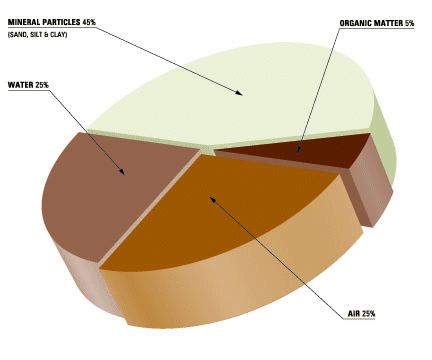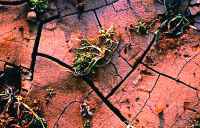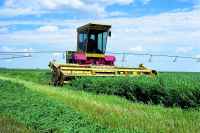| | Soils consist of four major components including organic matter, mineral particles, water and air (Figure 2.1).

Figure 2.1. Composition of soil
Adapted from: Agriculture and Agri-Food Canada and Ontario Ministry of Agriculture and Food. 1997.
Best Management Practices: Soil Management. Agriculture and Agri-Food Canada and Ontario Ministry of Agriculture and Food. p. 7.
Soil Organic Matter
Soil organic matter is composed primarily of plant residues in various stages of decomposition. It accumulates when the return or addition of plant residues is greater than their rate of decomposition by microbes. Organic matter occurs naturally in all Alberta soils, though the amount varies considerably from place to place (Table 2.1).
Table 2.1. Soil organic matter levels in cultivated soils in Alberta
| Ecoregion | Soil Zone | Percent Soil
Organic Matter |
| Peace Lowland | Dark Gray | 5 - 7 |
| Boreal Transition | Gray | 4 - 6 |
| Fescue Grassland, Aspen Parkland | Black | 5 - 7 |
| Moist Mixed Grasslands | Dark Brown | 4 - 5 |
| Mixed Grasslands | Brown | 1 - 3 |
Adapted from: Alberta Agriculture and Rural Development. 2001. AESA Soil Quality Benchmarks Study.
Alberta Agriculture and Rural Development, AESA Factsheet FS2001-1SQ.
Soil organic matter improves the physical and chemical properties of soil by:
- holding individual soil particles together in soil aggregates, thereby reducing the risk of soil erosion;
- improving soil structure, workability, aeration, water penetration and water-holding capacity;
- reducing the risk of crusting of the soil surface, which can reduce or prevent seedling emergence; and
- storing and supplying nutrients essential to plants and soil microorganisms.
Loss of soil organic matter results in reduced fertility, poor water-holding capacity, greater risk of erosion, and lower crop yields.
Factors affecting organic matter content:
- Organic matter tends to accumulate faster in cooler, wetter areas, and to decompose faster in warmer, drier areas.
- Crop rotations with more perennial forages, especially legumes, result in higher organic matter levels because these crops leave more residues than other crops. (Crop residues are the plant material remaining after harvest, including leaves, straw and roots.)
- Greater application of fertilizers, including manure, increases organic matter levels by increasing crop production and therefore the amount of crop residues.
- Tillage increases aeration, leading to faster decomposition of soil organic matter by soil microbes.
- Summerfallow decreases soil organic matter content over time because less plant residues are returned to the soil.
- Practices that leave the soil prone to erosion (see Section 2.2) increase the risk of organic matter loss by erosion.
- For more information, see The Health of Our Soils (Agriculture and Agri-Food Canada (AAFC)), Soil Organic Matter (Alberta Agriculture and Rural Development (ARD)), and Environmental Sustainability of Canadian Agriculture: Report of the Agri-Environmental Indicator Project (AAFC).

Soil crusting can reduce seedling emergence.
Courtesy of ARD
Aggregation is best under sod or no-till. Annual cultivation hastens decomposition of organic matter.
Courtesy of ARD

Legumes protect soil and add organic matter.
Courtesy of Roger Bryan
Back to Chapter 2 - Environmental Considerations |
|